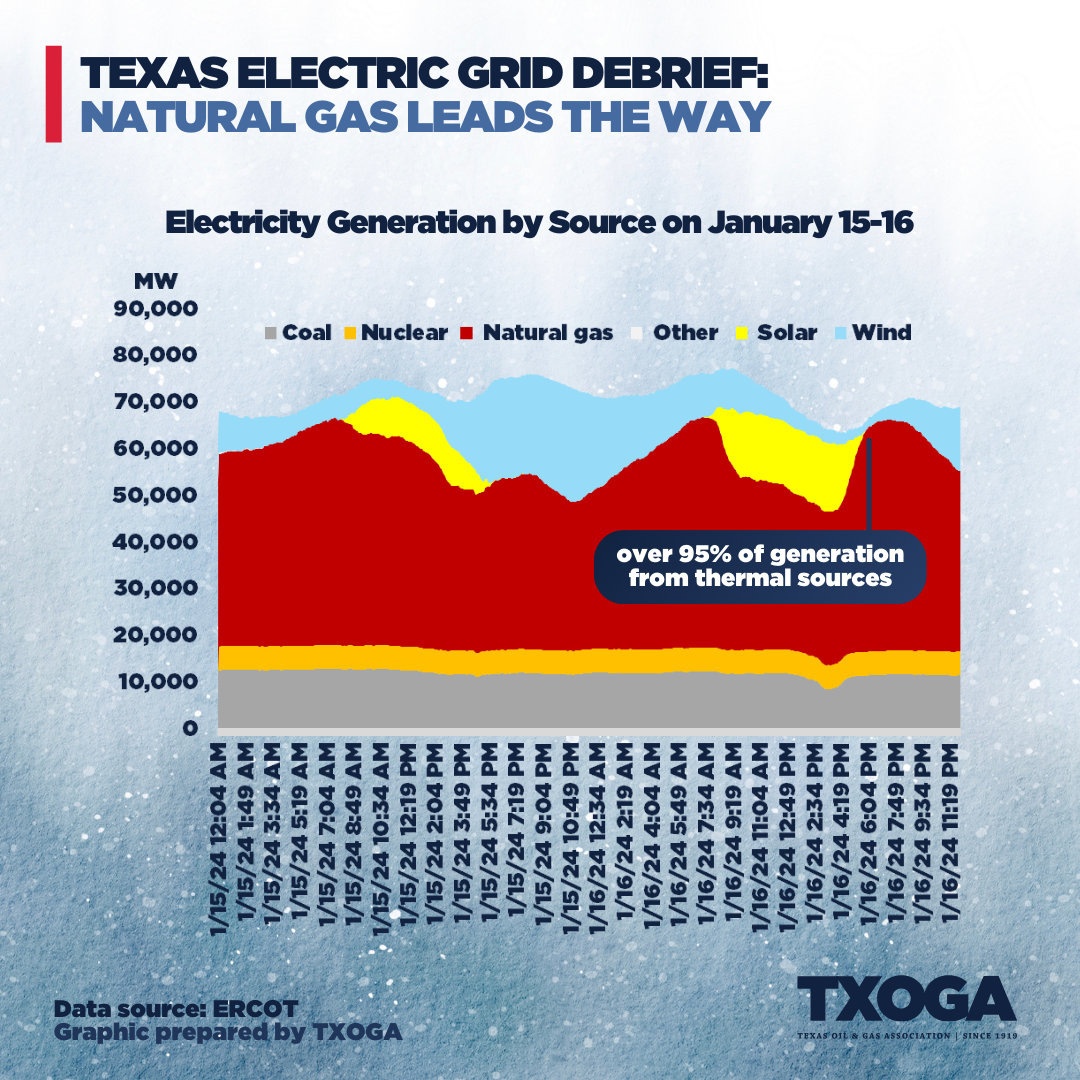In late January, Texans grappled with the unforgiving chill of Winter Storm Heather, enduring prolonged sub-freezing temperatures and icy precipitation statewide. The extreme conditions placed an unprecedented strain on the Lone Star State’s electric grid, escalating demand for energy. Winter Storm Heather now ranks as the third coldest storm to batter the Lone Star State in recent memory, following Winter Storm Elliot in December 2022 and Winter Storm Uri in February 2021.
Amidst the cold, thermal electricity sources, notably natural gas, emerged as the backbone of the state’s power supply, accounting for nearly 95% of electricity during peak demand. The robust performance of natural gas production, pipeline, and storage systems proved pivotal in sustaining the grid’s integrity.

“Congratulations to the men and women who fought through harsh conditions to keep Texans warm. This test on our electric grid means the reforms enacted by the Legislature yielded positive results. As electricity demand continues to grow, we look forward to working with the Public Utility Commission of Texas (PUC) as they seek to balance the need for more dispatchable generation with growing intermittent resources, and battery storage. Continual refinement of the needed generation mix and forecasting tools will assist in meeting Texas’ future power needs and benefit consumers with affordable and reliable electricity.” – Texas Oil & Gas Association (TXOGA) President Todd Staples
Legislative reforms, mandated by the Texas Legislature and Governor Greg Abbott post-Winter Storm Uri, yielded significant impacts. Essential changes included the weatherization of power generation facilities and prioritization of power for oil and natural gas field operations. Enhanced communication channels between key entities such as the Texas Division of Emergency Management (TDEM), the Public Utility Commission of Texas (PUC), the Electric Reliability Council of Texas (ERCOT), and the Railroad Commission of Texas (RRC) further fortified the state’s resilience.
According to TXOGA, throughout the storm natural gas-based electricity generation fueled as much as 50% to 60% of load across the ERCOT region all while new demand records were being set. ERCOT reported consecutive peaks, with January 14 witnessing a weekend winter peak of 70,982 megawatts (MW), followed by a weekday winter peak of 75,559 MW on January 15, and a subsequent peak of 78,138 MW on January 16.
Field conditions across Texas remained stable, with minor disruptions reported within the natural gas supply chain, swiftly resolved by responsive personnel. Despite anticipated reductions in production, Texas’ natural gas production, processing, transmission, and storage sectors efficiently met demand, ensuring minimal impact on distribution systems.
Despite the increase in demand, Texas consumers enjoyed steady natural gas prices amidst the storm, owing to the robust infrastructure of the state’s oil and gas sector. Despite price spikes observed nationwide, Texans experienced among the lowest natural gas prices, underscoring the economic and energy security conferred by the state’s extensive network.
The response to Winter Storm Heather showcased the indispensable role of the Texas natural gas sector in safeguarding the state’s energy resilience. Despite unprecedented challenges, the sector’s unwavering performance mitigated disruptions and ensured the comfort and security of Texans throughout the ordeal.
–
“Under extreme winter conditions, it’s clear that not all energy sources are created equal. Texas weathered Winter Storm Heather, thanks largely to the integral role that natural gas has played in ERCOT’s dispatchable thermal generation. Texas’ world-leading natural gas supply chain has continued to pay dividends, as preliminary data show record-high natural gas deliveries from storage on Monday and Tuesday, which simultaneously enabled robust electricity generation, residential and commercial heating, industrial production, and exports.” – TXOGA Chief Economist Dean Foreman
“Mandating that other critical infrastructure do the same really makes all the difference and the enhanced communication and coordination has been crucial during emergency weather events among personnel at key state agencies such as TxDOT, the Texas Division of Emergency Management, the Railroad Commission of Texas and ERCOT. It is for all the above reasons that the State of Texas is better prepared than ever to handle such extreme weather events and why it performed so well recently.” – Thure Cannon, Texas Pipeline Association President
“During Winter Storm Heather, Texas’ electric grid showcased its strength, largely powered by oil, gas, and coal. 95% of all power generated when we needed it most came from those three sources.” – Chairman Christi Craddick, Texas Railroad Commission.

